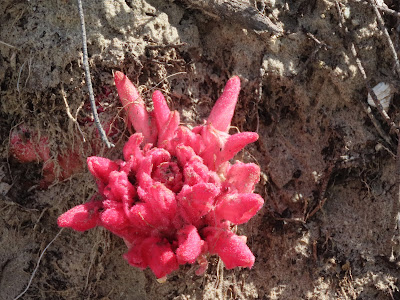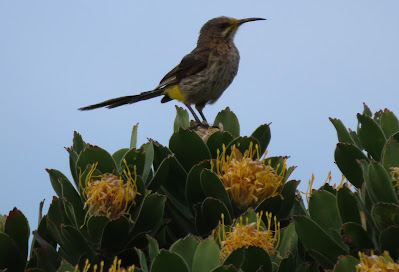Returning from Itala and just outside Pongola, the black monkey thorns Senegalia burkei were in prolific bloom and very evident.
A personal favourite, though not particularly beautiful, is the yellow-bellied greenbul and their nagging peh-peh-peh call is a constant reminder of their proximity. As usual as soon as you get a camera out they show you exactly what they think of you and you end up with the classic vent view!
Though there is a fairly large herd at Bonamanzi they are rarely seen, this mother was giving me the evil eyeball and daring me to get closer to her calf
This is Sarcophyte sanguinea , something I've never come across before. It parasitizes the roots of acacia species and is sexually diverse with the female plants below..............
..............and the males showing these white anthers. According to the great oracle Richard Boon, they smell of rotting flesh and are pollinated by flies. I didn't get close enough to confirm.
This is the time of year when the weeping boer beans Schotia brachypetala are copiously coated in scarlet flowers which literally drip nectar, hence the weeping appellation.
Always sad to leave such a beautiful spot but cataract ops were calling so started heading back to Durban where my cousin Sue's husband Giles, who is an eminent ophthalmologist, had kindly agree to sort them out. I stopped for what was meant to be a brief stay at Umlalazi Lagoon in Mtunzini. There appear to be only two zebra left in the reserve and on a couple of mornings I awoke to their soft snuffling right outside my window.
A few mornings later I went out birding on the Honda and had a senior moment. I had taken the long route to a likely finfoot spot and decided to come back along a footpath shortcut. What I hadn't bargained on was the wash away at this spot. So I'm approaching from the far side of this pond and I'm confronted with this minor obstacle. Why not turn around I hear you say, well I wont say impossible but the section is raised and only a little over a metre wide so I figured that riding over the pipe was the best option - which would have be a doddle 30 years ago! The Universe decided to teach the old fool that he is no longer bullet-proof.
As the front wheel crested the pipe the back wheel snagged on a rock and I needed legs about half a metre longer to reach anywhere. Result, 208 kg of bike on top of me in the water with very rough chunks of concrete below and my left leg trapped. The extraction process removed a lot of skin and caused much damage to knee, ankle and foot. So what now? There's no way I can lift it by myself and the nearest help is 3 km away. My binoculars, spectacles and camera all took a swim and even though the camera was in the backpack it expired. I eventually located the bins in a metre of water (thank heavens for Zwarovski nitrogen sealing) but my glasses are still there. So I'm pouring blood and barely capable of walking but set off gamely (or gammy-ly). Had only made a hundred metres when I heard a bakkie approaching and was overwhelmed to a see couple of rangers with six other people on the back. They were extremely concerned and we soon had the Honda back on the road, I pressed the starter button and viola, simply unbelievable. Back at base I showered and tried to find the first aid kit, which, unbeknown to me, must have been taken when the Beast was burgled in the Cape. A visit to the pharmacy provided what I required plus, mercifully, a pair of crutches on loan at no cost - love these small villages. A number eye-watering applications of merthiolate soon produced a scab which obviated nightly dressings.......
Fortunately found a willing assistant to help load the bike but setting up camp was a two day affair, While the massive fig provided shade it also was very generous with it's fruit so a constant rain went on day and night with bats and birds competing for who could provide the most copious quantities of crap.
Fortunately the fruit was used up after about 10 days and after a flurry of campers who call themselves the Penny Pinchers left, there were only 3 other vans in this massive camp site.
An obvious difference between this and my last visit is that the trains no longer run, which is a country-wide malaise caused by rampant vandalism and theft. I was astounded to find out that even the dedicated railway from the coal fields to Richards Bay no longer operates; which accounts for the massive increase in trucks on a road system already under strain.
It is a great pity to witness the gradual return to a very third world country but there are still some very beautiful spots if you take the time to look.













.jpg)


























